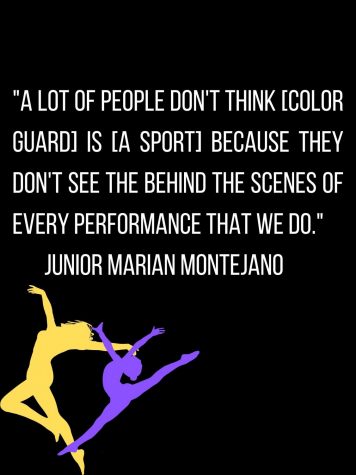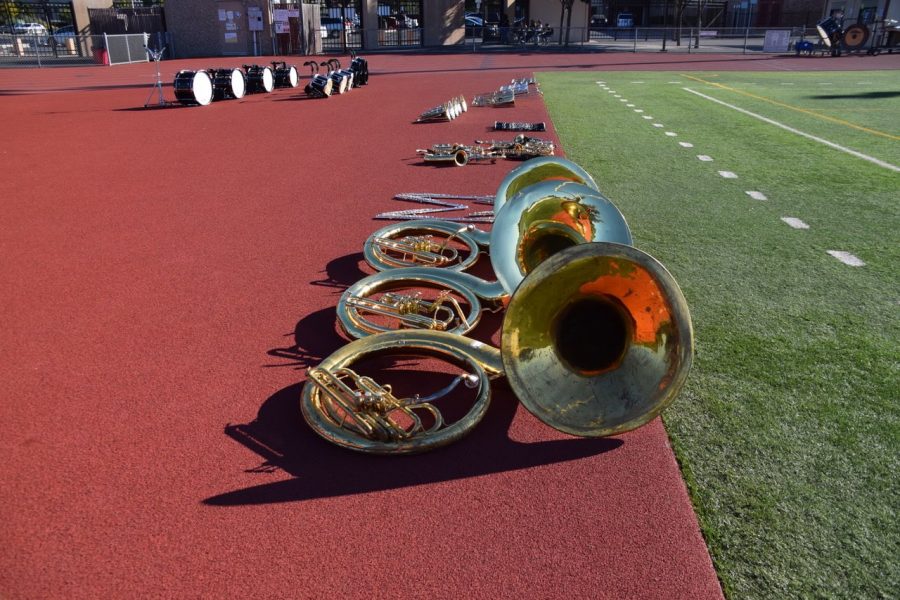Blurring the lines between art and sports
Students and teachers reflect on activities like color guard, dance and marching band
August 29, 2021
Purple and gold flags fly six feet into the air. Dancers pirouette across the gym floor. A cacophony of saxophones and trumpets echo throughout the open band room door. The sights and sounds of many of the artistic enterprises spill into classrooms during lunch time and football fields during halftime, blurring the lines between art and sports.
“Color guard is definitely a sport,” junior Marian Montejano, a member of color guard, said. “A lot of people don’t think [color guard] is [a sport] because they don’t see the behind the scenes of every performance that we do. They see the finished product that lasts four minutes compared to the hour-long games of other sports. We are going through lots of routines and we’re drilling down entire choreos to try to learn them. It’s not nearly as easy as people think.”

Similarly, Physical Education department lead and dance teacher Dasha Plaza firmly believes that the demanding physicality of dance is why it should also be considered a sport.
“Trying out dance will let people see how much energy and effort and focus goes into it,” Plaza said. “You work every inch of your body, even the smallest muscles that you might never use when you do other [sports] and you have to stay very involved. And unless you try [dance], I think people underestimate that.”
John Gilchrist, the director of instrumental music and marching band director, supervises and helps create the marching band performances. While he believes that marching band should be considered a sport due to the physical exertion and heavy conditioning, he notes it tends to be viewed as less of a sport because of its creative aspect.
“If you’re playing on a football team, it doesn’t matter how beautifully you play out there, it’s about [if] you win the game,” Gilchrist said. “With marching band, I try to stay away from that mindset of ‘crushing the other bands’ and I try to focus more on are we creating something that’s beautiful and artistically valid.”
In contrast, Plaza asserts that competition is actually a defining feature of dance.

“Competition builds character and pushes your own personal boundaries further,” Plaza said. “Without that competitive aspect, you don’t grow as an athlete or a person. Dance has a strong competitive aspect and is largely focused on demonstrating skill better than other dancers. People that never had that exposure to [dance] need to be a little bit more open minded [about] how similar dance is to other competitive sports.”
Montejano conveys that the best way to dispel rumors around artistic activities like color guard is to welcome newcomers and create a supportive environment to promote the connections the activity offers.
“It’s actually very wholesome, in a way,” Montejano said. “Everybody is so giving and generous and they always want people to come to join because it is such a friendly space for everybody to enjoy. New members are very important because they create the next generation of color guard and I think it’s amazing to find new students and physically show them what color guard is about.”
Ultimately, Gilchrist believes that defining an activity as a sport does not contribute to the value of participating in dance, marching band or color guard.
“Not being a sport doesn’t make an [activity] any less valid,” Gilchrist said. “I think that we do a really good job at Monta Vista in providing the chance for students to participate in these things. Though winning trophies is great, our number one goal should always be to create something that demonstrates a high level of artistic achievement.”
















